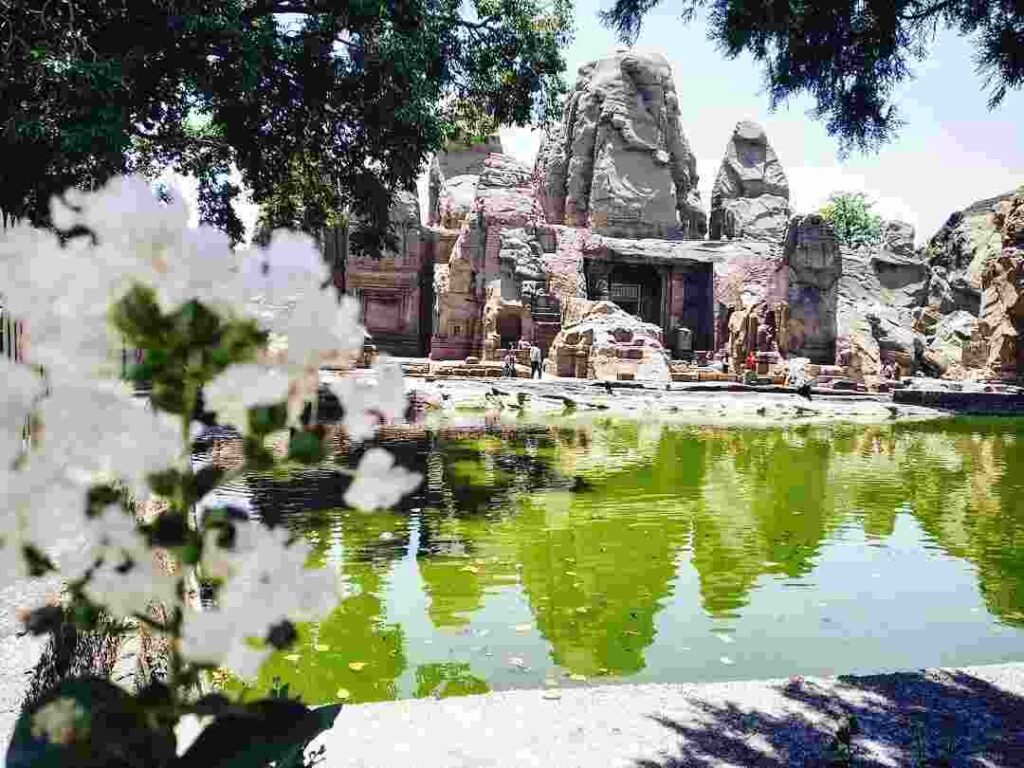Masroor Rock-Cut Temple, An Archeological Marvel in Kangra 2025
Masroor Rock-Cut Temple, An Archeological Marvel in Kangra 2024: The Masroor Rock-Cut Temples, also known as Masroor Temples, are a group of early 8th-century rock-cut Hindu temples located in the Kangra Valley of Himachal Pradesh, India. The temples are carved from a single massive sandstone rock and face northeast towards the Dhauladhar range of the Himalayas.

The architectural style of the Masroor Temple is a version of the North Indian Nagara style. The temples are dedicated to the Hindu deities Shiva, Vishnu, Devi, and Surya. The surviving iconography of the temples is likely inspired by a henotheistic framework, which is the belief in one supreme God while still acknowledging the existence of other lesser deities.
The Masroor Temple are an archaeological marvel and a popular tourist destination. The temples are located about 50 kilometers from McLeodganj, which is a popular hill station in Himachal Pradesh. The nearest railway station is Nagrota Surian, and the nearest airport is Dharamshala.
Story Behind Masroor Rock-Cut Temple
In the foothills of the Dhauladhar range, where the wind whispers secrets through the pines, lies the enigmatic Masroor temple complex. Carved from the living rock by unknown hands, it stands as a sentinel to time, its origins shrouded in mist.
One popular legend speaks of the Pandavas, the legendary heroes of the Mahabharata. During their exile, they stumbled upon this valley, its beauty a balm to their weary souls. Inspired by the majestic mountains, they decided to build a stairway to heaven itself. Night and day, they tirelessly carved into the rock, their chisels echoing through the valley.
But the gods grew nervous. Should mortals be allowed such a direct path to their celestial abode? So, disguised as a crow, Indra, the king of gods, landed upon the unfinished steps. With a loud caw, he announced the break of dawn, tricking the Pandavas into believing their work was complete.
When they saw the sun peek over the horizon, they realized they had been deceived. Disheartened, they abandoned the project, leaving behind the magnificent, yet incomplete, temples of Masroor.
Masroor Rock-Cut Temple
Another tale whispers of Raja Yashodharman, a pious king devoted to Lord Shiva. He dreamt of a divine vision, urging him to build a temple complex in honor of the mighty god. With unwavering faith, the king gathered skilled artisans and set about fulfilling his vision. Years passed, the sound of chisels resonated with devotion, and the temples began to take shape.
However, fate intervened. A series of natural disasters and political upheavals forced the king to abandon the project. The temples, frozen in time, stand as a testament to his dedication, a silent prayer etched in stone.
The truth behind Masroor’s creation may forever remain a mystery. But its silent grandeur continues to inspire awe. Tourists marvel at the intricate carvings, pilgrims whisper prayers by the sacred pool, and children weave their own fantastical stories about the forgotten builders. The Masroor temple complex, a bridge between myth and reality, stands as a timeless reminder of human ambition, devotion, and the enduring power of stories.
Masroor Rock-Cut Temple
Archeological Significance
The Masroor Rock-Cut Temples hold significant archaeological importance for several reasons:

- Unique Construction: Unlike most North Indian temples built from bricks or stone, Masroor showcases monolithic rock-cut architecture, similar to the famous Ellora and Ajanta Caves. This method of carving an entire temple complex out of a single giant rock is rare in North India, making Masroor a standout example.
- Fusion of Styles: The temples represent a blend of the North Indian Nagara style with elements of rock-cut cave architecture. This unique fusion provides valuable insights into the artistic and architectural influences of the period.
- Uncertain Origin: The exact date and patronage behind the construction remain shrouded in mystery. The absence of inscriptions or historical records creates an intriguing puzzle for archaeologists.
- Potential Lost City: The presence of caves and ruins surrounding the temple complex hints at a potentially larger settlement in the Masroor region. Studying these remnants can shed light on the social and cultural aspects of the community that built the temples.
- Artistic Legacy: The surviving sculptures and friezes depict major Hindu deities and stories, offering a glimpse into the artistic expressions and religious beliefs of the era.
Despite damage from earthquakes and remaining incomplete, the Masroor Rock-Cut Temples offer a valuable window into the architectural and artistic heritage of Himachal Pradesh. Further research and preservation efforts can unlock more secrets about this enigmatic archaeological treasure.
Cultural Significance
The Masroor Rock-Cut Temples hold deep cultural significance for several reasons:
- Representation of Diverse Hinduism: The temples are dedicated to various Hindu deities from prominent traditions like Shiva, Vishnu, Devi, and Surya. This inclusivity showcases the rich tapestry of Hindu beliefs and practices during the temple’s construction period.
- Link to Local Legends: Local folklore attributes the temple’s creation to the Pandavas from the epic Mahabharata or the Katoch dynasty. These stories, even if not historically accurate, highlight the temple’s significance in local cultural memory and traditions.
- Symbolism and Rituals: The carvings and reliefs depict scenes from Hindu mythology, offering a visual representation of religious narratives for devotees. The presence of a sacred water pool likely held ritualistic importance for worshippers.
- Architectural Heritage: The temple complex represents a unique architectural style and craftsmanship. It stands as a testament to the skills and artistic expression of the builders, fostering a sense of cultural pride and appreciation for their legacy.
In conclusion, the Masroor Rock-Cut Temples are not just archaeological marvels but also significant cultural landmarks. They represent the diversity of Hinduism, local legends, and artistic heritage, offering a valuable connection to the past for visitors and local communities alike.
Here are ways to reach Masroor Rock-Cut Temples:
By Air
The nearest airport to Masroor Rock-Cut Temples is Gaggal Airport (Dharamshala Airport), located approximately 35.6 kilometers away. This airport has frequent flights connecting it to Delhi.
By Train
The nearest railway station to Masroor Rock-Cut Temples is Daulatpur Chowk Railway Station. This station is connected to major cities in Himachal Pradesh. From there, you can hire a cab or take a bus to reach the temples.
By Road
Masroor is well connected by roads to other cities in Himachal Pradesh and nearby states. You can either take a government HRTC bus or a private taxi to reach the temples.
Here are the distances from some nearby cities:
Dharamshala: 41.3 kilometers
Manali: 253 kilometers
Shimla: 226 kilometers
Chandigarh: 234 kilometers
Delhi: 500 kilometers















